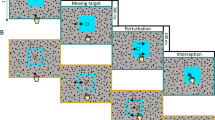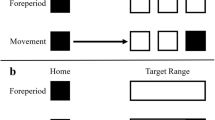Abstract
In point-to-point reaching movements, the trajectory of the fingertip along the horizontal plane is not completely straight but slightly curved sideward. The current paper examines whether this horizontal curvature is related to the height to which the finger is lifted. Previous research suggested that the height to which the hand is lifted might be a determinant of horizontal curvature. We asked participants to make point-to-point movements in three conditions: constrained movements (i.e., fingertip keeps contact with table top) over vertically curved surfaces that differed in height, constrained movements over a flat surface, and unconstrained movements (i.e., fingertip lifted from table top). In constrained movements, we found a strong relation between horizontal curvature and lifted height of the finger. Interestingly, for unconstrained movements, the relation between horizontal curvature and height to which the finger was lifted was weak. This demonstrates that the height to which the finger was lifted relates to horizontal curvature in some, but not in all conditions. This suggests that the height to which the hand is lifted should be included, in particular for constrained movements, when giving a full account of horizontal curvature in point-to-point movements.




Similar content being viewed by others
Notes
Due to mistakes in data collection, a total of 4 movement conditions of different participants were incorrect. These missing values were replaced using the EM procedure in SPSS that estimates the means, the covariance matrix, and the correlation of variables with missing values, using an iterative process. The missing conditions were: participant 6, direction 90°, surface height 3.0 cm; participant 10, direction 0°, surface height 3.0 cm; participant 11, direction 90°, unconstrained; participant 14, direction 90°, surface height 4.5 cm.
References
Ambike S, Schmiedeler JP (2013) Invariant geometric characteristics of spatial arm motion. Exp Brain Res 229:113–124
Bakeman R (2005) Recommended effect size statistics for repeated measures designs. Behav Res Methods 37:379–384
Bongers RM, Zaal FT (2010) The horizontal curvature of point-to-point movements does not depend on simply the planning space. Neurosci Lett 469:189–193
Cohen J (1988) Statistical power analyses for the behavioral sciences. Erlbaum, Hillsdale
Desmurget M, Jordan M, Prablanc C, Jeannerod M (1997) Constrained and unconstrained movements involve different control strategies. J Neurophysiol 77:1644–1650
Desmurget M, Prablanc C, Jordan M, Jeannerod M (1999) Are reaching movements planned to be straight and invariant in the extrinsic space? Kinematic comparison between compliant and unconstrained motions. Q J Exp Psychol A 52:981–1020
Gordon J, Ghilardi MF, Cooper SE, Ghez C (1994) Accuracy of planar reaching movements. II. Systematic extent errors resulting from inertial anisotropy. Exp Brain Res 99:112–130
Haggard P, Richardson J (1996) Spatial patterns in the control of human arm movement. J Exp Psychol Hum Percept Perform 22:42–62
Osu R, Uno Y, Koike Y, Kawato M (1997) Possible explanations for trajectory curvature in multijoint arm movements. J Exp Psychol Hum Percept Perform 23:890–913
Palluel-Germain R, Boy F, Orliaguet JP, Coello Y (2004) Visual and motor constraints on trajectory planning in pointing movements. Neurosci Lett 372:235–239
van Andel C, van Hutten K, Eversdijk M, Veeger D, Harlaar J (2009) Recording scapular motion using an acromion marker cluster. Gait Posture 29:123–128
van der Graaff MCW, Brenner E, Smeets JBJ (2013) Misjudgment of direction contributes to curvature in movements toward haptically defined targets. J Exp Psychol Hum Percept Perform 40:802–812
van der Steen MM, Bongers RM (2011) Joint angle variability and co-variation in a reaching with a rod task. Exp Brain Res 208:411–422
van Thiel E, Meulenbroek RGJ, Hulstijn W (1998) Path curvature in workspace and in joint space: evidence for coexisting coordinative rules in aiming. Mot Control 2:331–351
Wolpert DM, Ghahramani Z, Jordan MI (1994) Perceptual distortion contributes to the curvature of human reaching movements. Exp Brain Res 98:153–156
Acknowledgments
We thank Bjorn de Laat and Floor Lok for their help with collecting the data and Hans Tholen for constructing the surfaces. We appreciate the help of Henry van de Crommert and Emyl Smid for keeping the equipment running. We thank Chrisitian Greve, Laura Golenia, and Tim Valk for the useful feedback while writing this paper.
Author information
Authors and Affiliations
Corresponding author
Rights and permissions
About this article
Cite this article
Tuitert, I., Mouton, L.J., Schoemaker, M.M. et al. The effect of the height to which the hand is lifted on horizontal curvature in horizontal point-to-point movements. Exp Brain Res 232, 3211–3219 (2014). https://doi.org/10.1007/s00221-014-4009-7
Received:
Accepted:
Published:
Issue Date:
DOI: https://doi.org/10.1007/s00221-014-4009-7




